Natural stone is one of the most popular materials used for construction and decoration of buildings and fences. It allows you to create an individual design, reliable construction. A stone fence is popular because it goes well with other buildings on the site, looks beautiful and lasts a long time.
- General information about stone fence
- Pros and cons of fencing
- Varieties of stone for building a fence
- Types of masonry
- Preparatory work
- Calculation of the amount of material
- What tools will be needed
- The order of construction work
- Pouring the foundation
- Installation of supports
- Laying out spans
- Stone fence decoration
General information about stone fence
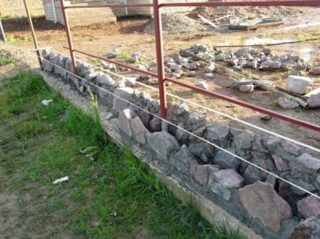
Before making such a design, you need to consider its constituent parts. The fence includes the following elements:
- Foundation. Since the weight of the stone is large, the base must be solid. Failure to comply with the technology of its installation will lead to rapid subsidence and destruction of the fence.
- Supports. They support stone spans, preventing the appearance of cracks, chips.
- The actual stone walls. Different materials are used for their construction. It all depends on the height, design of the fence, and its area.
A stone fence can be solid or with gaps. If the first option is selected, it should not be too high. The second type of fencing is characterized by the alternation of building material with gaps. Combination options are also popular. It is supposed to combine stone with wood, brick, metal profiles, concrete slabs, and are decorated with forging.
An interesting type of fencing is the gabion. It is a metal mesh frame filled with stone.
Pros and cons of fencing
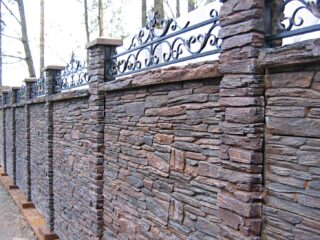
Natural stone fences have the main advantage - a long service life. Other advantages:
- combination with any architectural style of the house;
- naturalness of the material, environmental safety of the elements;
- a high degree of decorativeness of the structure;
- reliable protection against the spread of fire;
- ease of installation, despite the laboriousness of the process;
- a variety of options for making fences made of natural stone.
The design has disadvantages:
- high cost of material (the most expensive are elements that have certain decorative characteristics);
- the need to build a solid foundation.
You can reduce the cost of construction by erecting a fence made of artificial stone. Such material is made from acrylic resins, stone chips or painted concrete.
Varieties of stone for building a fence
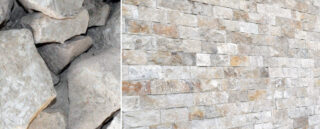
The construction of the fence is carried out using artificial or natural stone. Most often, these types of material are used:
- Cobblestone. This is a cheap option, as you can find such a stone everywhere. More often fences are made of crushed stone. The disadvantage is not a very high degree of decorativeness.
- Gravel, pebbles. These materials are more often used for finishing fencing. The construction of a pebble fence is impractical, because the stones are small.
- Booth. Its dimensions range from 6-50 cm. The main part of the structure is made of it or used to finish the surface of the foundation.
- Dolomite. This material is flat. Large elements are used to erect the main part of the wall.Its advantage is ease of use, attractive appearance.
- Limestone. Due to the simple structure, the presented stone has low strength and durability, therefore, it is rarely used for the construction of spans. In humid climates, limestone quickly collapses and requires additional moisture protection.
- Sandstone. It is resistant to weather conditions, temperature extremes, and has high strength.
For construction, let's say the choice of an artificial fence stone.
Types of masonry
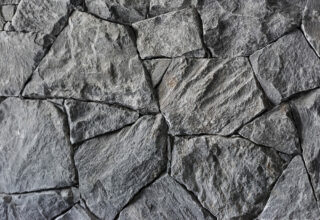
For the construction of the fence, different types of masonry are used:
- wild: elements have different shapes and sizes, but fit close to each other;
- plank: stones are processed and polished so that they get a rectangular shape;
- flat horizontal: in this case, layered minerals are used;
- flat vertical;
- rubble: use round elements, for the installation of which formwork is required.
The choice of the type of masonry depends on the selected material, the area of the structure, and its cost.
Preparatory work
To make a stone fence with your own hands, preparation is required: marking the site, calculating the necessary materials, selecting tools.
Calculation of the amount of material
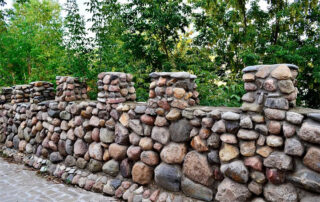
To calculate the amount of stone, you need to know the height of the fence, its length, as well as the thickness of the wall. It is advisable to lay out one section of the fence, and then multiply the amount of material spent by the number of spans. Standard dimensions: the distance between the posts is 2.5 m, the height of the wall is 2 m. The width of the fence ranges from 20-50 cm. When calculating, you can use an online calculator.
What tools will be needed
To erect a fence made of wild stone, the following tools and devices are required:
- container for the preparation of concrete solution;
- bayonet and shovels;
- welding machine (if the fence is high);
- concrete mixer;
- hammer, sledgehammer;
- measuring tape, cord and wooden stakes for marking;
- mortar trowel;
- plumb line, building level, square;
- screwdriver.
In addition to stone, sand, cement and crushed stone are required for pouring the foundation, waterproofing material. To strengthen the base, use steel reinforcement (it is connected with a knitting wire). To assemble the formwork, boards and self-tapping screws are used.
The order of construction work
After the marking of the site for the fence from cobblestone or other stone has been made, you can proceed to earthworks, pouring the base and erecting the wall.
Pouring the foundation
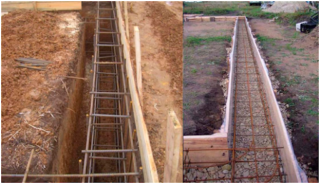
Arrangement of the base involves the following stages of work:
- Trench preparation. Its depth is 70-120 cm, width - 50-60 cm. The bottom is leveled, covered with sand and gravel, moistened and compacted. After that, the waterproofing material is laid.
- Formwork installation. A reinforcing frame is laid inside the structure. In places where the posts will be built, metal pipes are installed.
- Pouring solution. After laying the mixture, it is compacted. The structure must be moistened for 3-5 days.
Further work is carried out in 21-28 days.
Installation of supports
For the installation of a fence made of decorative stone (other material), supports are required. For their manufacture, formwork is installed along the width of the pillars. Building material is tightly laid inside the structure, the voids are filled with concrete. Gradually, the formwork is moved upward. During the day, you should not lay supports with a height of more than 1 m.
Laying out spans
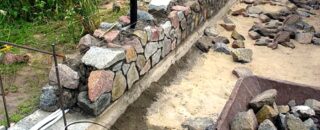
The optimal size of the material for the spans of the fence is up to 20 cm. A hammer or perforator is used to crush the elements. Installation provides for the following sequence of works:
- Application of mortar to the foundation.
- Laying stone on both sides of the span (symmetrically). The correctness of the installation is controlled by the level and the marking thread.
- Laying the first row. The voids and cracks are filled with cement mortar.
Installation of the next row is carried out in a day.
Stone fence decoration
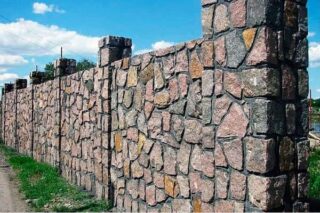
To improve the appearance of the fence, jointing is performed. They are shallow, deep, or convex. To do the work, you need foam rubber, a brush with a metal bristle. The procedure is carried out 3-4 hours after the laying. The master decorates the fence near the house in accordance with the order.
Since you can make a stone fence yourself, such designs are very popular. A variety of building materials and ways of laying them allows you to create a unique project that will delight the eye for more than a decade.








